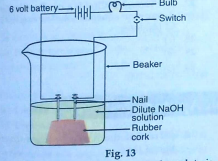A
B
C
D
Text Solution
Verified by Experts
|
Topper's Solved these Questions
ACID, BASES AND SALTS
MODERN PUBLICATION|Exercise EXERCISE|433 VideosView PlaylistCARBON AND ITS COMPOUNDS
MODERN PUBLICATION|Exercise EXERCISE|410 VideosView Playlist
Similar Questions
Explore conceptually related problems
MODERN PUBLICATION-ACID, BASES AND SALTS-EXERCISE
- Which of the following substance is brittle?
03:02
|
Play - Which of the following is acidic in nature?
01:52
|
Play - In an attempt to demonstarate electrical conductivity through an elect...
03:52
|
Playing Now - Which of the following is used for dissolution of gold?
01:26
|
Play - Which of the following is not a mineral acid?
02:26
|
Play - Which among the following is not a base?
01:47
|
Play - Which of the following statements is not correct?
01:52
|
Play - Match the chemical substances given in column with their appropirate a...
02:46
|
Play - Equal volumes of hydrochlric acid and sodium hydroxide solutions of th...
02:55
|
Play - Which of the following is true when HCl is passed throug water?
01:42
|
Play - Which of the following statements is true for acids?
01:15
|
Play - Which of the following are present in a dilute aqueous solution of hyd...
01:19
|
Play - Identify the correct representation of reaction occuring during chlora...
02:37
|
Play - Which of the following statement is not correct?
02:39
|
Play - When black copper oxide placed in a beaker is treated with dilute HCl,...
01:07
|
Play - Metal hydrogen carbonates react with acids to give
01:29
|
Play - pH of the solution having hydrogen ions concentration of 1M is
01:35
|
Play - Which of the following acidic solutions having given pH values is most...
01:24
|
Play - Which of the following aqueous solution will have highest depression i...
03:34
|
Play - Which of the following is not a strong acid?
02:07
|
Play
